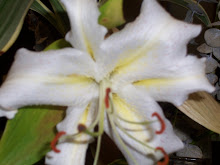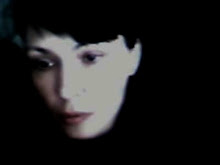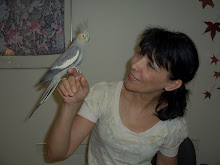I feed sparrows 3 to 4 times each day on weekdays for three years now. These are my independent observations.
To an average onlooker sparrows may have look like one grey, faceless flock of …birds. Most of my co-workers don’t have an idea what these birds are called. If I would call sparrows “robins” or “finches” they (average onlookers) wouldn’t even try to question my knowledge!! Most people I know can only be certain that these birds are NOT pigeons! Growing up in European countries, I have always known names of local birds as well as plants, garden flowers and trees.
Color and Size. The female sparrows are more grayish and evenly-colored; the males have deeper colors with an addition of dark brown and black. Males are easily recognized by black collar around their necks. Girls are being girls (!) - I found them prettier and even cute. Males have more serious, somber looks! In terms of size, I would say they are about the same. Even when females are with eggs, it is undetectable. Unless they stay in their nests the entire pregnancy!
Feeding. I feed them mostly with plain (supermarket) bread. I have tried to feed them assorted seeds but the sparrows have very little or no interest in it. In terms of feeding manners, sparrows almost never fight: they have tendency to take/confiscate from others as if “others’” piece of bread is tastier (“grass is always greener…”) They let others to take from them without protesting. Thinking of exceptions, I’ve noticed that during mating season, birds get very agitated and frantic and may start skirmish easily, but it is not common during other seasons. In fact, during brutal winter weather, birds stay close to each other; when there is food they make enough noise to call for other birds to join and to share. Another example of aggressive behavior while feeding is when youngsters do get introduced to “communal” feeding grounds. They usually approach food in rather charging manner and make aggressive noises – scare tactics? As they get more mature, they follow general rule of sharing and acceptable behavior.
Nesting. In my observation, only males are involved in nest-building. However, I would call them lazy “builders” as they get easily distracted when they see me and …food! Whatever “building materials” they were carrying in their mouths, i.e. feathers, pieces of paper towel, dry grass, etc., they drop it and after brief feeding often forget about their duties.
I am not sure that sparrows really “build” their nests: most likely they try to improve/make livable any hole or crack they could find. During dry and cold weather I noticed them hiding on the ground in heaps of dry leaves.
Mating. Starting in February though April there are noticeable differences in sparrows’ behavior: they get very agitated, aggressive and nervous. During this period even their facial expression (!) is different: withdrawn, exhausted, suspicious etc.
Not all but most of males are involved in courting rituals. They dance with such dedication and persistence that is …enviable to me!! Male lowers and stretches his wings that they almost touch the ground. In that position he is hopping in front of his “girl” for hours, absolutely certain that he is irresistible in that pose! I can only imagine how very exhausting and muscle-straining this courtship could be! I have a feeling that older males are more skillful in this sort of dance.
Injuries. I have mistakenly thought that males are more aggressive than females during mating period. Not at all!! Females defend their rights/virginity (!) with unimaginable bravery and fight just as hard!!! I did observe that during this period birds are often get injured. Most disturbing injury is when they get their eyes put out. I noticed only females with this type of injury. Most likely they get injured by males’ beaks during mating. The eye is closed, looks hollow underneath the eyelid and tearing heavily. I assume they get blind in injured eye however, after the mating season is over I haven’t seen birds blinded in one eye. Whether they die or recover, I wouldn’t know.
A couple of days ago I was watching one female sparrow that couldn’t stand on her feet as if she was partially paralyzed. She could barely fly, couldn’t land easily. While on the ground, her body was tilting to her left side; she was having difficulties keeping her balance and was basically sitting on her belly… I was trying to pick her up but she wouldn’t let me near. I was throwing pieces of bread close to her and she ate. I watched her a few times during the same day but didn’t see her the following day. I would assume that her thigh was injured but couldn’t have closer look.
When I watch two birds fighting, I have noticed that they use their beaks and feet and those are most dangerous weapons! It reminded me of (animated) dinosaurs’ fight!!
Sparrows’ beaks and claws are very strong and sharp. I think this is how my sparrow-girl’s thigh was injured.
When the bird is sick, it is not translated in their facial expression, however, their body language says “I am not well” or “I think I am dying”... They blink a lot and their blinks are long. Yet no matter how sick they might have been, they rarely lose their appetite. I have noticed that the sick ones are always left alone.
Babies. In June - July first baby-sparrows make their first flights or should I say, their first fall. They don’t actually fly, they throw themselves from their nests, catching waves and, may God help them!... For many of them their first landing would be their last one… Some baby birds are falling out from their nests too soon and are too weak to maneuver. For homeless straight cats it is indeed feasting period.
Parenting. Whether mothers or fathers are better parents, I could only make my assumptions by watching them during feeding. Babies could be easily recognized by their cute oversized yellow mouths. They hopping and flopping their wings frantically, demanding food from whoever is nearby! Most responsive to their demands are, as strange as it may sounds, males! They stuff babies’ mouths with crumbs/pieces of bread whether it is their baby or neighbor’s! Sometimes, they feed them with pieces that are too big and make little sparrows choke. I don’t think males are worried too much about that, as long as baby keeps its mouth shut for awhile!
Personal Hygiene. Like all birds, sparrows do have fleas and probably other parasites. Just like chickens, sparrows like sand/dirt-bathing. But during cold seasons when the ground is wet and dirty, I’ve watched them bathing in our little park’s custom-made waterfall. The temperature is rather cold, yet they don’t mind! Most likely itchiness from fleas gets unbearable.
Visual memory. When I go out for a smoke during the day, it usually takes less than 2 seconds for “my flock” to “recognize” me! – If one sees me, it immediately sends a signal to all of them, wherever they are. There are other people go out for a smoke or simply standing in front of the building during the day. Yet “my” sparrows don’t approach them, don’t consider “them” as the source of food.
There is a small park that separates the Nursing Home from the residential area. Many times, especially in the winter, I was greeted by my birds hundreds of feet away from the Home/feeding spot; many times they were following me when I was walking away from the building when taking my lunch breaks. I don’t know what their visual memory or sense of smell like, but I do know they unmistakably recognize the “source of food” very well!
Look closer at sparrows or any birds for that matter! At first, their faces all look alike! As you get used to them, you couldn’t help noticing they are …different. Just like human faces, some are pretty, some are shy, some – serious, some are friendly, some are grumpy, some are little “brave hearts”!...
We, as humans, share 97% of our genes with pigs, 70% - with daffodils, I am sure with birds the sharing percentage is somewhere in between, which makes them our ancestral relatives!!
April 15, 2008

















.jpg)


3 comments:
Dear Natalie,
I bumped into your website while researching about sparrows' sand/dirt bathing.
I was walking along the Canal Griboedova in St. Petersburg, Russia, last night, where I currently live, and saw many sparrows bathing in the dirt by the small bushes. There were about 30 or so birds and all are doing this activity which I had never seen before. I was fascinated to see it and kept watching it for a while. It's white night season and days are long and beautiful here.
I tried googling about it and came to your site. I did a google search in Japanese, since I am Japanese, and found a similar commentary, but yours was more complete and solved the mystery.
Thank you!
I am glad that my little observations helped to solve a “mystery”!!!
I guess, it is only because of white nights that you were able to observe sparrows quite late in the evening. Thank you.
Interesting.
I have fed and provided water for birds where I have lived for years, and protected them as best I am able. Next to canines, I love birds the most.
Post a Comment